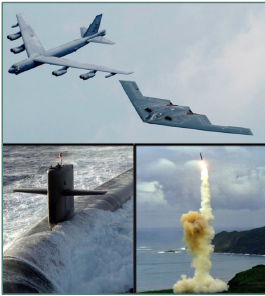triadpic.png [1]


For over sixty years, the United States has maintained a large and costly nuclear arsenal, composed of heavy bombers, submarine-launched missiles, and intercontinental missiles. Perhaps it's time for a change.
Of course, so long as nuclear weapons exist in the world, the U.S. must maintain a credible and reliable deterrent to adversaries, while guaranteeing security to U.S. allies.
Nonetheless, the U.S. strategic triad could be restructured in such a way as to further reduce overall nuclear forces and save money without sacrificing international security. The U.S. initially diversified its nuclear force structure in response to the Soviet arms buildup and the threat of mutual assured destruction. Today, threats to the United States and U.S. interests abroad still exist, but they are of the scope and size that no longer warrant maintaining a triad. If anything, retaining our overwhelming force now can signal to adversaries that the U.S. is still locked in a Cold War mindset, and can incentivize new nuclear buildups globally.
Moreover, in the face of difficult budget constraints on Capitol Hill, maintaining a triad may not be the best way forward. So what is the most stable force structure that is both cost-effective and credible?
By eliminating any two legs of the U.S. triad, the cost savings would be tremendous. At present, the United States maintains 14 Ohio-class nuclear ballistic missile submarines, 450 deployed Minuteman III ICBMs, and a total of 94 nuclear-capable bombers. We spend about $30 billion a year to maintain and operate this arsenal. Eliminating any two of these legs would save billions of dollars annually.
As Ploughshares Fund grantee Tom Collina [2] of the Arms Control Association wrote earlier this month, the Pentagon will soon be analyzing changes to current force structure and posture, which could include "moving from a nuclear force based on a triad of delivery vehicles ... to a dyad that might eliminate nuclear-armed bombers."
Gary Samore, White House WMD policy czar, recently echoed this sentiment, saying, "We've reached the level in our forces where further reductions will raise questions about whether we retain the triad or whether we go to a system that only is a dyad. Those are important considerations."
Our current system is costly and redundant. Eliminating two legs and moving to a monad -- or even eliminating only one leg and moving to a dyad -- would be an improvement on the status quo. Not only would it enhance national and international security, it would save money. It is a smart and sensible step.
UPDATE: This article reflects changes made to an earlier version.
Links
[1] https://ploughshares.org/file/2418
[2] http://www.armscontrol.org/act/2011_06/NuclearGuidance